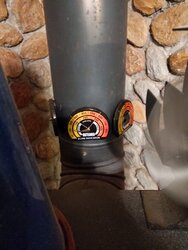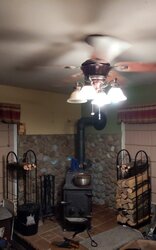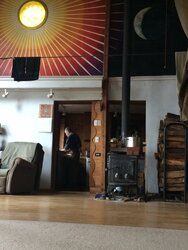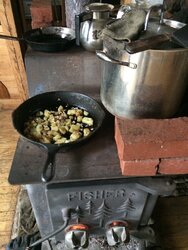I've been living with woodstoves for 35 years and have never seen anything like this. For the past four years I've been living with a Fisher Papa Bear. It's a great stove and I like it. It's got brick lining and five fin draft control knobs, so I think it's UL listed (post 1980?). But when I shut it down to smolder overnight, the flue gets pressurized and forces creosote out of anyplace it can escape. Here's the situation:
The stove has been modified in three ways. The rear vent was covered and a top vent installed. A baffle was installed. And at one point it had a hot water manifold in the firebox so there are two small outlets for waterlines in the rear which are now capped. The flue is 6", same as stock, and rises straight up with no bends or elbows. There is 12' of single wall black pipe up to the ceiling (cathedral ceiling), a slip connector, and probably a 3' section of metalbestos chimney, which exits near the roof peak so it's top is higher than any part of the roof. The draw is nothing short of voracious. Open the damper and it sounds like a jet taking off. My wood is well seasoned (stacked on pallets in the California sun) and overwhelmingly hardwood (tanoak, madrone, California black oak, Oregon white oak, manzanita, and occasionally a little California bay laurel or coffee berry). Knowing the bay laurel tends to create creosote, I almost never use it when the stove is shut down overnight. I use Douglas fir limbwood, but only when I have the damper wide open to speed up taking out the chill in the room after a period of shutdown. At least once a day, and always in the morning after the night's long shutdown, I open the damper fully and crank the stove at full bore for at least 40 minutes to help burn off residue in the pipe. The flue is constructed with the crimped ends down, so creosote should just drip back into the stove.
But instead, it began leaking out the (properly sized) hole for the damper rod, and the seams of the snap locked black pipe. It rotted the pipe so I replaced the entire 12' with heavier gauge single wall black pipe, with welded seams. I got rid of the damper, so no holes. After only two or three months of use, now the creosote is forcing it's way through the welded seams and dripping down the outside of the pipe. I can see no gaps in the seams visually, after the creosote burns off. That sounds like some serious pressure. Why does the creosote not just drip down the inside of the pipe into the firebox? I've spoken with two different technical help engineers at Selkirk (metalbestos' manufacturer) and they are both (pardon the expression) baffled. The only remotely plausible explanation was that maybe the house is tight enough to starve the shut down stove from enough air to avoid the pressurization. Except that would be laughable; this is far from a tight house, including many single pane windows and some with discernible drafts. Yesterday one of them referred me to this fine website, where I spent some time researching threads.
What sort of voodoo may be tormenting me? I understand that using double wall black pipe is supposed to help with creosote issues, but I would prefer to keep it single wall if possible for more heat radiance into the room.
The stove has been modified in three ways. The rear vent was covered and a top vent installed. A baffle was installed. And at one point it had a hot water manifold in the firebox so there are two small outlets for waterlines in the rear which are now capped. The flue is 6", same as stock, and rises straight up with no bends or elbows. There is 12' of single wall black pipe up to the ceiling (cathedral ceiling), a slip connector, and probably a 3' section of metalbestos chimney, which exits near the roof peak so it's top is higher than any part of the roof. The draw is nothing short of voracious. Open the damper and it sounds like a jet taking off. My wood is well seasoned (stacked on pallets in the California sun) and overwhelmingly hardwood (tanoak, madrone, California black oak, Oregon white oak, manzanita, and occasionally a little California bay laurel or coffee berry). Knowing the bay laurel tends to create creosote, I almost never use it when the stove is shut down overnight. I use Douglas fir limbwood, but only when I have the damper wide open to speed up taking out the chill in the room after a period of shutdown. At least once a day, and always in the morning after the night's long shutdown, I open the damper fully and crank the stove at full bore for at least 40 minutes to help burn off residue in the pipe. The flue is constructed with the crimped ends down, so creosote should just drip back into the stove.
But instead, it began leaking out the (properly sized) hole for the damper rod, and the seams of the snap locked black pipe. It rotted the pipe so I replaced the entire 12' with heavier gauge single wall black pipe, with welded seams. I got rid of the damper, so no holes. After only two or three months of use, now the creosote is forcing it's way through the welded seams and dripping down the outside of the pipe. I can see no gaps in the seams visually, after the creosote burns off. That sounds like some serious pressure. Why does the creosote not just drip down the inside of the pipe into the firebox? I've spoken with two different technical help engineers at Selkirk (metalbestos' manufacturer) and they are both (pardon the expression) baffled. The only remotely plausible explanation was that maybe the house is tight enough to starve the shut down stove from enough air to avoid the pressurization. Except that would be laughable; this is far from a tight house, including many single pane windows and some with discernible drafts. Yesterday one of them referred me to this fine website, where I spent some time researching threads.
What sort of voodoo may be tormenting me? I understand that using double wall black pipe is supposed to help with creosote issues, but I would prefer to keep it single wall if possible for more heat radiance into the room.
Last edited:






